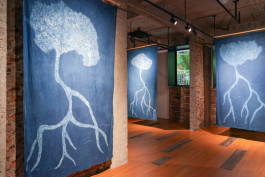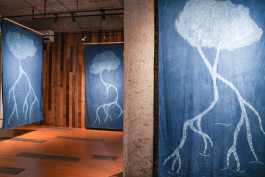
Marking the border between land and sea, the mangrove trees stand at the water’s edge exposed to waves, tides, strong winds, and shifting sea levels.
Trees are thought of as static. “Rooted” is a word we might use to describe them - we might describe a human belonging to a place the same way. But when I think of seeds, blossoms, roots, and rhizomes, it is movement that I think of.
Mangroves are sometimes called “walking trees” - their intricate root systems give the impression of legs, as if they’re striding above the water; their seeds, once mature, travel with the tides until they find suitable ground to root themselves - a natural movement through dispersal.
Humans never stopped migrating, despite the diversity of their circumstances, motives or the conditions that drove them to it. I have never stopped moving either. I’ve made and left homes in several places. Living as migrants, learning how to begin anew, asks us to be agile, flexible, like those plants growing on the edge between environments. Carried across global currents, uprooted, finding ourselves and planting ourselves again in another place – I wonder, what would it mean to move and yet stay rooted?
红树是热带与亚热带沿海地区、海陆交界处特有的木本植物。无论海浪、潮汐、强风和海平面的变化,它们始终矗立在水边。
我们通常认为树木是静止的,树木会“扎根 ”——这也是我们用来形容个人对地方的归属感的词汇。但当我想到种子、花朵和根茎时,我想到的是“流动”。
红树有时被称为 “行走的树”—— 它们的树根纵横交错,在水上下同时生长,仿佛在水面上大步流星;红树种子是胎生苗,一旦成熟脱离母株,就会随波逐流,直到找到合适的土地扎根——这是一种通过散播实现的自然流动。
人类从未停止过迁徙,虽然各自的环境、动机或条件都不相同。我也从未停止过搬迁,我在多个地方成家又离开。移民生活、学习如何重新开始,我们变得敏捷而灵活,就像那些生长在环境边缘的植物一样。在全世界代代移民迁移的历史中,我们被连根拔起,在另一个地方找回自我,重新植根。我在想,“移动着”而又同时“扎根着”意味着什么?











Seven trees, a forest
Textile installation
240x140cm each

Marking the border between land and sea, the mangrove trees stand at the water’s edge exposed to waves, tides, strong winds, and shifting sea levels.
Trees are thought of as static. “Rooted” is a word we might use to describe them - we might describe a human belonging to a place the same way. But when I think of seeds, blossoms, roots, and rhizomes, it is movement that I think of.
Mangroves are sometimes called “walking trees” - their intricate root systems give the impression of legs, as if they’re striding above the water; their seeds, once mature, travel with the tides until they find suitable ground to root themselves - a natural movement through dispersal.
Humans never stopped migrating, despite the diversity of their circumstances, motives or the conditions that drove them to it. I have never stopped moving either. I’ve made and left homes in several places. Living as migrants, learning how to begin anew, asks us to be agile, flexible, like those plants growing on the edge between environments. Carried across global currents, uprooted, finding ourselves and planting ourselves again in another place – I wonder, what would it mean to move and yet stay rooted?

红树是热带与亚热带沿海地区、海陆交界处特有的木本植物。无论海浪、潮汐、强风和海平面的变化,它们始终矗立在水边。
我们通常认为树木是静止的,树木会“扎根 ”——这也是我们用来形容个人对地方的归属感的词汇。但当我想到种子、花朵和根茎时,我想到的是“流动”。
红树有时被称为 “行走的树”—— 它们的树根纵横交错,在水上下同时生长,仿佛在水面上大步流星;红树种子是胎生苗,一旦成熟脱离母株,就会随波逐流,直到找到合适的土地扎根——这是一种通过散播实现的自然流动。
人类从未停止过迁徙,虽然各自的环境、动机或条件都不相同。我也从未停止过搬迁,我在多个地方成家又离开。移民生活、学习如何重新开始,我们变得敏捷而灵活,就像那些生长在环境边缘的植物一样。在全世界代代移民迁移的历史中,我们被连根拔起,在另一个地方找回自我,重新植根。我在想,“移动着”而又同时“扎根着”意味着什么?










Seven trees, a forest
Textile installation
240x140cm each